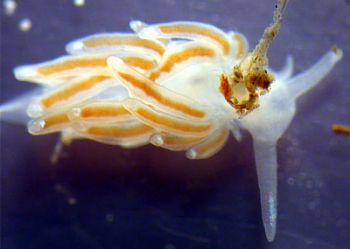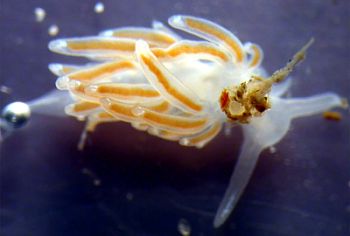Flabellina spp
from North Atlantic
See messages below discussing the species of Flabellina found in the North Atlantic, including both the European and Nth American coasts.
Authorship detailsRudman, W.B., 2001 (July 18) Flabellina spp from North Atlantic. [In] Sea Slug Forum. Australian Museum, Sydney. Available from http://www.seaslugforum.net/find/flabnatla
Related messages
Juvenile Flabellina from Sweden
December 19, 2001
From: Mike Noren


The following sea slug was collected recently on the Swedish west coast, at Tjärnö, probably from a sample of red algae with a lot of assorted epifauna collected from 8 - 15m depth. It was about 4mm long.
Sorry about the rhinophores - I tried to remove the debris which had stuck to them, but I would have ripped the slug before getting rid of it. Best guess here is Flabellina nobilis or Flabellina browni.
Incidentally, isn't there a lot of virtually identical species in the Flabellina / Coryphella genera, or is it just me?
Mike Noren
mike_noren@hotmail.com
Noren, M., 2001 (Dec 19) Juvenile Flabellina from Sweden. [Message in] Sea Slug Forum. Australian Museum, Sydney. Available from http://www.seaslugforum.net/find/5830Dear Mike,
I asked Bernard Picton and Jussi Evertsen, who jointly prepared the key for North Atlantic species of Flabellina, to have a go at identifying your photo. I have put their replies below. As you can see, it seems a bit difficult to identify them from photos when they are so small. Concerning your question about too many species. Although some species are difficult to separate on general body shape and colour, there are good distinguishing characters to be found in the internal anatomy (including the radular morphology), and probably in aspects of their natural history (food, development time, etc.).
•Comment from Bernard Picton [bernard.picton.um@nics.gov.uk]:
Hi Bill - The Flabellina is a juvenile so very difficult to be certain. From the hefty oral tentacles and short broad-based tail I'd guess that it might be F. salmonacea, if the sender has located a place where there is a settlement of juveniles perhaps they can look again in the spring to see what they grow up into. - Bernard Picton
•Comment from Jussi Evertsen [jussi.evertsen@vm.ntnu.no]:
Hi Bill! - The image looks to me as if it could be a Coryphella, with the long
oral tentacles and distinct footcorners. Also the cerata seems to be arranged in transverse rows and in groups, which excludes species of Coryphella with cerata set one by one (gracilis), and with cerata set in continous rows (nobilis and so forth). Also the individual shown in the picture seems young. I could suggest this species to be either Coryphella verrucosa (rufibranchialis form) or a Coryphella browni as described by Bernard Picton. - Jussi Evertsen
Thanks Bernard and Jussi,
Bill Rudman
Flabellina in the North Atlantic
July 28, 2001
From: Bernard Picton
Hi Bill,
I'll attempt to offer some light on the Flabellina species in the N Atlantic. Many of the species actually occur on both sides of the Atlantic. On the European side we have all of the American species, but some do not extend as far south as the British Isles and Jussi Evertsen is familiar with them so he can help with this. The amphiatlantic species seem to occur in Iceland and Greenland and may maintain continuous populations across the Atlantic - they seem to be the more cold-tolerant species.
Southern distribution limits in the NE Atlantic (European side) are:
Flabellina verrucosa - southern limit Irish Sea
Flabellina salmonacea - southern limit Norway
Flabellina gracilis - south to Atlantic coast of France
Flabellina pellucida - southern limit W Scotland - I've found one specimen in Ireland (in Lough Hyne, almost the warmest place here - I wouldn't believe it until I checked the radula!)
Flabellina nobilis - previous southern limit Norway, Faeroes - I have one unpublished Irish record - a single juvenile specimen but I'm fairly positive about the identification.
Also - not found on American side of Atlantic:
Flabellina borealis - southern limit North Sea
Flabellina browni - south to Atlantic coast of France
Flabellina lineata - south to Mediterranean
Flabellina pedata - south to Mediterranean
There has been taxonomic confusion over these species and occasionally I'll check the radula but I think I can normally distinguish living animals OK.
Flabellina borealis is a bit of an unknown as far as living appearance goes but Jussi and I just looked at a sample of animals caught in the North Sea by Anne Dewicke of Univ. of Gent, Belgium and they are quite distinctive in their ceratal arrangement. The cerata are unclustered and taper in size to very small ones which are numerous at the sides and in an extensive region at the tail end, extending very near to the tip of the tail. The painting by Lemche in Just and Edmunds, 1985 shows an animal with clustered cerata and I think this is a misidentification. With hindsight I think Walton's 1908 report of animals from the North Sea identified as Coryphella salmonacea were probably F. borealis. Anne caught the animals in a hyperbenthic sledge at 70 m depth just north of the Dogger Bank, they were 'white and orange-red' in colour and the bottom was soft mud and detritus. There were over 500 individuals in the sample - Ann describes it thus: 'When the sledge came up and was still hanging outside, we were wondering what those orange-red beasts could be. They were so brightly coloured that we all thought they might be a sort of shrimp! '
I attempted to make a key to identification of N Atlantic Flabellina on external living characters. Jussi Evertsen simultaneously sent a similar key to the Forum, so at your suggestion we have prepared a joint version. We have not included Flabellina parva and Flabellina islandica as we have no personal experience of living animals of these, but the other 9 species should separate all right.
Bernard
bernard.picton.um@nics.gov.uk
Picton, B.E., 2001 (Jul 28) Flabellina in the North Atlantic. [Message in] Sea Slug Forum. Australian Museum, Sydney. Available from http://www.seaslugforum.net/find/4733Dear Bernard,
Thanks for your thoughts on these animals and the various photos you have sent recently which show distinguishing characters not already illustrated on the Forum. It has been a necessary preparation for the posting of this key.
Best wishes,
Bill Rudman
Flabellina in the North Atlantic
July 28, 2001
From: Jussi Evertsen
Dear Bernard and Bill!
It is great to see that there is great interest in the north Atlantic species of Flabellina. I must first be allowed to say that I prefer the use of Coryphella, as I explain on my website at http://www.ntnu.no/~vmzotbak/nudibranchia
I have myself had the opportunity to have collected and studied most of the species mentioned in Bernard's mail, except F. islandica, F. parva and F. browni. When identifying species of Flabellina it might in the beginning be quite confusing with cerata sticking out everywhere and rhinophores and white rings and oral tentacles to look for. But I have in my own experince found three reliable features to keep in mind; the arrangement of the cerata, the placement of the anus, and the shape of the rhinophores. One thing I have found to be impossible to use as a good feature, is colouration, except for F. pedata and F. lineata. The use of rings or white tips of the cerata can be very variable, as can be seen in F. verrucosa (which also has a list of synonyms as long as a full roll of toilet paper), and also the shape of the cerata. Also the colour of the cerata (or the digestive glands to be precise) seems to vary according to what the nudibranch is feeding upon. I have seen variable colouration of the cerata in F. verrucosa, F. gracilis, F. pedata, and F. nobilis. I can but confirm Bernard's observation on F. pellucida having a liking to Eudendrium (all three species actually). Also the shape of the cerata is very variable, especially in F. verrucosa. It seems to be three distinct groupings of Flabellina from north atlantic waters concerning ceratal arrangement; those with a continous arangement of the cerata along the sides of the back (as seen in salmonacea, borealis and partly in F. nobilis), those with cerata set on a common stalk (F. pedata and F. pellucida) and those with cerata arranged in distinct groups (with or without further arrangement of cerata in each group in clear rows; see F. verrucosa). The shape of the rhinophores and localisation of the anus seems to be both distinct and shared features between the species, but are useful tools when identifying the species. So far I have not yet seen any Flabellina species with lamellate rhinophores as seen in species within Flabellina from the Mediteranean and tropic.
Attached is a "field-key" which is an amalgamation of a key that I have been using and regularly modifying, and one that Bernard Picton has developed for his own use. Clearly the best way to identify these animals is to look at their anatomy but this is not always practical and of little use in the field or in identifying photos. So we hope this key will be useful for anyone trying to identify their North Atlantic Flabellina.
Yours sincerely
Jussi Evertsen
Trondhjem Biological Station
Norwegian University of Technology and Science
jussie@stud.ntnu.no
Evertsen, J., 2001 (Jul 28) Flabellina in the North Atlantic. [Message in] Sea Slug Forum. Australian Museum, Sydney. Available from http://www.seaslugforum.net/find/4876Dear Jussi,
Thanks for your thoughts and for the work Bernard and you have done to prepare this key.
Cheers,
Bill Rudman
